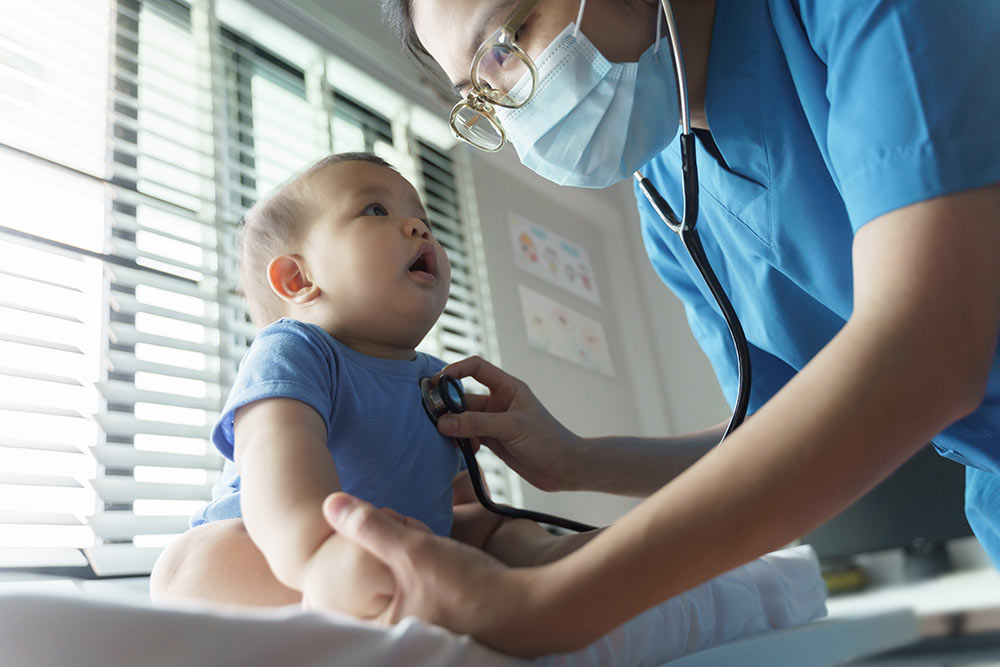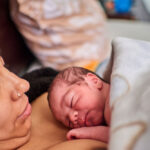Understanding RSV

Pediatric cases are rising across the nation—here’s what parents of young children need to know.
Medical Experts: Carol J. Baker, MD; Deborah Mulligan, MD
The U.S. is bracing for what’s being called a “tripledemic” of coinciding winter surges in COVID-19, influenza (flu), and respiratory syncytial virus (RSV). Of the three respiratory viruses, the flu and COVID-19 are well-known threats, but RSV, in particular, is life-threatening to younger babies as a leading cause of infant mortality around the world.
According to the Centers for Disease Control and Prevention (CDC), an estimated 58,000 to 80,000 children younger than 5 years old are hospitalized due to RSV infection annually. This year, since early October alone, approximately one in every 500 babies aged 6 months or younger with RSV required hospitalization, and that estimate is growing every day. Experts suspect this spike is due in large part to masking and social distancing practices over the past few years during the pandemic; those who would typically have been exposed to the respiratory illness were not (and did not pass on the virus to young infants), and the higher-than-usual number of cases today reflects how many Americans are not maintaining the same protective measures.
While worrisome, there are measures you can take to prevent infection and protect your family if illness strikes. Know the early warning signs of severe RSV to better monitor worsening symptoms and know when to seek medical attention.
Symptoms and Prevention
RSV infects the lungs and breathing passages; it’s the most common cause of bronchiolitis (inflammation of the small airways in the lung) and pneumonia in children under 1-year-old in the U.S.
Prevalent in fall, winter, and early spring, RSV is highly contagious and can easily spread in schools and daycare centers. In fact, nearly all children will have been infected with RSV by the time they turn 2, says Deborah Mulligan, MD, professor of Pediatrics at Nova Southeastern University in Fort Lauderdale, Florida. The infection is no more troublesome than the common cold in most pediatric cases, but for children most at risk—those who were born prematurely, or those with heart disease or a lung condition—RSV can become serious.
Much like the flu, RSV is passed through the air by sneezing or coughing from an infected person; it can also live on hard surfaces, such as doorknobs, countertops, tables, and crib railings for many hours, which is unfortunate considering babies put hands, toys, and everything else in their mouths. What’s also troubling is that there is currently no vaccine or treatment for cases of RSV. For high-risk babies, doctors might recommend injections of monoclonal antibodies that can help prevent infection during peak RSV season. The injections are costly, though, and only administered in special cases.
According to Carol J. Baker, MD, professor of pediatrics at the McGovern Medical School at the University of Texas Health Science Center in Houston, research is underway to develop a vaccine for RSV. Last week, Pfizer announced that it has enough promising data on its RSV vaccine designed for newborns that it plans to submit for US Food and Drug Administration (FDA) approval by the end of the year. In the meantime, Dr. Baker advises parents to practice healthy habits like frequent handwashing, making sure baby stays hydrated, and avoiding sick people. Additionally, parents should avoid touching their infant’s face with unwashed hands and instruct other adults and older children to not touch or kiss their baby.
While some RSV symptoms mirror a common cold, such as a runny nose or decreased appetite, other symptoms will develop within 2 to 5 days after making contact with the virus. Typical symptoms of RSV are:
- Labored or quick breathing (60+ breaths per minute)
- Difficulty feeding
- Lasting cough
- Bluish fingernails
- High fever (100.4+ for newborns)
- Wheezing
- Excessive tiredness and lethargy
- Thick nasal discharge that is yellow, green, or gray
- Signs of dehydration
Even though RSV is not always a severe illness, it warrants supervision from a health care provider to assess the severity of the virus. More facts about RSV can be found here.
This article was originally published in 2016 and has been updated by Lauren Lisle.







